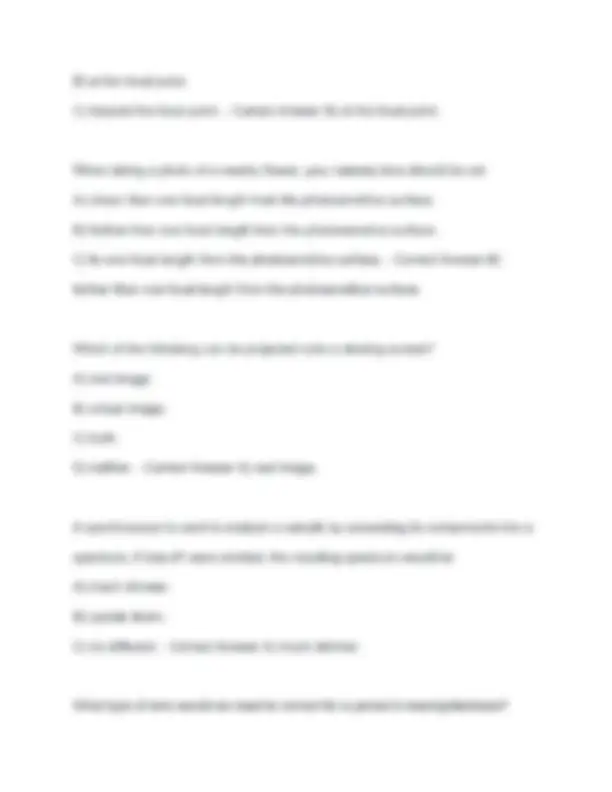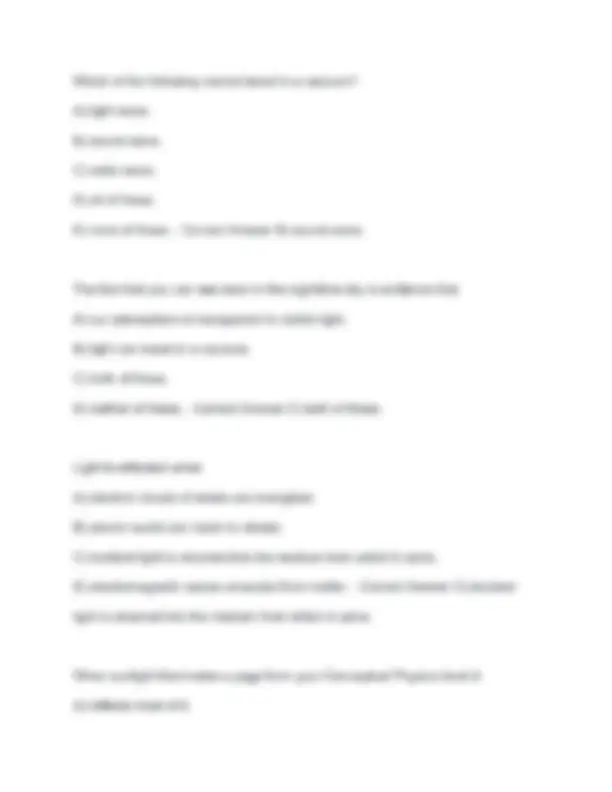Partial preview of the text
Download Physics 1260 Exam 3 Conceptual Questions With Verified Answers (Graded A) and more Exams Physics in PDF only on Docsity!
Most of the waves in the electromagnetic spectrum are A) red light. B) blue light. C) green light. D) invisible. - Correct Answer D) invisible. Light travels from one place to another along a path of least A) distance. B) time. C) effort. D) expense. E) complication. - Correct Answer B) time. When a pulse of white light is incident on a glass prism, the first color to emerge is A) red. B) orange. C) green. D) violet. - Correct Answer A) red. The index of refraction for crown glass, common in eyeglasses, is 1.52. The index of refraction for a particular plastic lens is 1.76. Light bends more in the A) crown glass. B) plastic lens. C) same in each. D) need for information. - Correct Answer B) plastic lens. The image of the "infinitely-far-away" Sun produced by a converging lens appears A) between the lens and the focal point. B) at the focal point. C) beyond the focal point. - Correct Answer B) at the focal point. A "pinhole camera" has no lens. The tiny pinhole opening ensures that rays of light from different parts of an object A) overlap. B) don't overlap. C) bend to a focus. - Correct Answer B) don't overlap. In a converging lens, objects infinitely far away are focused A) in front of the focal point. A) converging. B) diverging. - Correct Answer B) diverging. A magnifying glass has a certain focal length. Compared to this magnifier, a second glass with a thicker lens will have a focal length that is A) longer. B) shorter. C) the same. - Correct Answer B) shorter. The ocular in a microscope behaves like a(n) A) eye piece. B) magnifying glass. C) objective. D) burning glass. - Correct Answer B) magnifying glass. Electromagnetic waves consist of A) the compression and refraction of electromagnetic pulses. B) oscillating electric and magnetic fields. C) particles of light energy. D) high-frequency sound waves. - Correct Answer B) oscillating electric and magnetic fields. Which of the following cannot travel in a vacuum? A) light wave. B) sound wave. C) radio wave. D) all of these. E) none of these. - Correct Answer B) sound wave. The fact that you can see stars in the nighttime sky is evidence that A) our atmosphere is transparent to visible light. B) light can travel in a vacuum. C) both of these. D) neither of these. - Correct Answer C) both of these. Light is reflected when A) electron clouds of atoms are energized. B) atomic nuclei are made to vibrate. C) incident light is returned into the medium from which it came. D) electromagnetic waves emanate from matter. - Correct Answer C) incident light is returned into the medium from which it came. When sunlight illuminates a page from your Conceptual Physics book it A) reflects most of it. When a light ray enters water at 15 degrees from the normal, it A) always bends towards the normal. B) always bends away from the normal. C) sometimes bends towards or away from the normal. D) does not bend. - Correct Answer A) always bends towards the normal. Which are the consequences of different speeds of light in different media? A) mirages. B) rainbows. C) brilliant colors of diamonds. D) all of these. E) none of these. - Correct Answer D) all of these. The type of lens that spreads parallel light is a A) converging lens. B) diverging lens. C) combination of converging and diverging lenses. - Correct Answer B) diverging lens The type of lens that brings parallel light rays together is a A) converging lens. B) diverging lens. C) combination of converging and diverging lenses. - Correct Answer A) converging lens 















